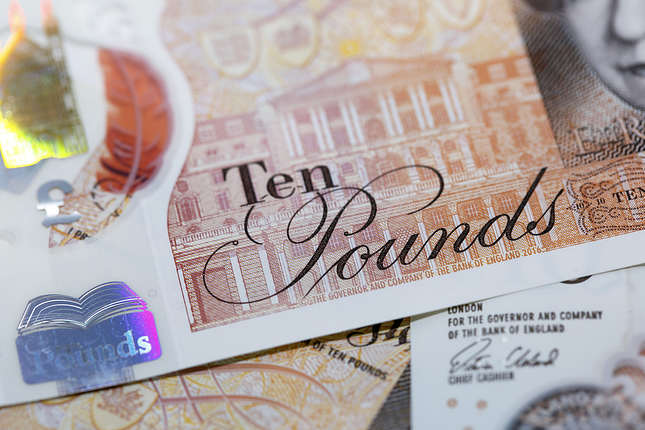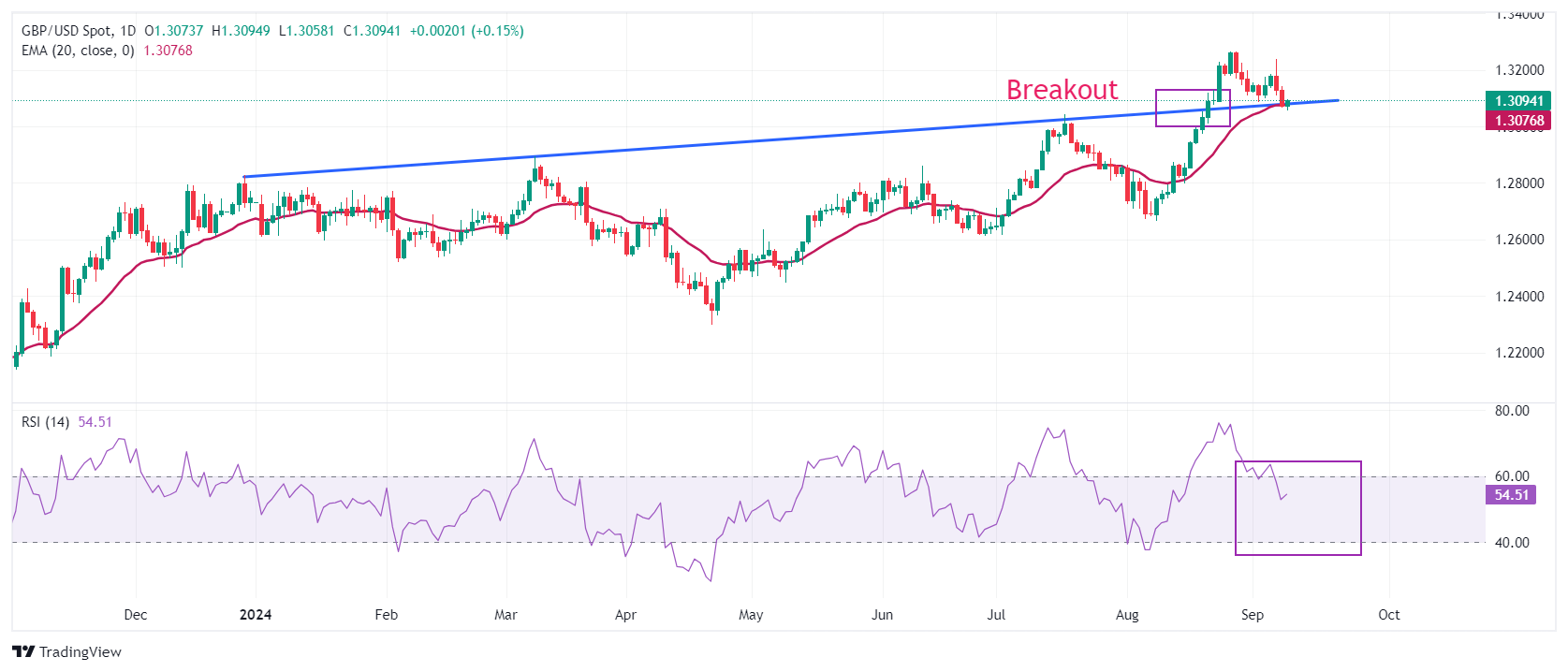- The Pound Sterling extends its downside against the US Dollar as investors shift focus to the US inflation.
- UK job growth remained robust in the three months ending in July.
- An expected decline in the UK wage growth would prompt BoE interest rate cut prospects for this month.
The Pound Sterling (GBP) trades higher against its major peers, except the US Dollar (USD) and the Canadian Dollar (CAD), in Tuesday’s New York session after the release of the mixed United Kingdom (UK) Employment report for the three months ending in July. The British currency strengthens as the UK Office for National Statistics (ONS) reported a robust labor demand, while the wage growth eased broadly in line with expectations.
The agency reported that the ILO Unemployment Rate expectedly declined to 4.1% from the prior release of 4.2%. UK employers hired 265K new workers, significantly higher than the former release of 97K. Historically, robust job growth boosts hawkish Bank of England (BoE) bets. Still, it is less likely to be in this scenario as Average Earnings data, a wage growth measure that drives inflation in the service sector, has decelerated expectedly.
BoE policymakers have remained worried about persistent inflation due to high inflation in the services sector. A slowdown in the wage growth momentum would relieve them and boost market speculation for BoE interest rate cuts this month.
Average Earnings Excluding Bonuses came in at 5.1%, as expected, the lowest reading in two years, against the former release of 5.4%. The wage growth data, including bonuses, decelerated faster than expected to 4%, from estimates of 4.1% and the prior reading of 4.6%, upwardly revised from 4.5%.
Going forward, investors will focus on the UK monthly Gross Domestic Product (GDP) and factory data for July, which will be published on Wednesday.
British Pound PRICE Today
The table below shows the percentage change of British Pound (GBP) against listed major currencies today. British Pound was the strongest against the Canadian Dollar.
| USD | EUR | GBP | JPY | CAD | AUD | NZD | CHF | |
|---|---|---|---|---|---|---|---|---|
| USD | 0.12% | 0.13% | -0.40% | 0.36% | 0.24% | -0.01% | -0.29% | |
| EUR | -0.12% | 0.02% | -0.52% | 0.24% | 0.12% | -0.16% | -0.41% | |
| GBP | -0.13% | -0.02% | -0.54% | 0.20% | 0.11% | -0.17% | -0.40% | |
| JPY | 0.40% | 0.52% | 0.54% | 0.74% | 0.63% | 0.35% | 0.10% | |
| CAD | -0.36% | -0.24% | -0.20% | -0.74% | -0.13% | -0.37% | -0.63% | |
| AUD | -0.24% | -0.12% | -0.11% | -0.63% | 0.13% | -0.26% | -0.52% | |
| NZD | 0.00% | 0.16% | 0.17% | -0.35% | 0.37% | 0.26% | -0.25% | |
| CHF | 0.29% | 0.41% | 0.40% | -0.10% | 0.63% | 0.52% | 0.25% |
The heat map shows percentage changes of major currencies against each other. The base currency is picked from the left column, while the quote currency is picked from the top row. For example, if you pick the British Pound from the left column and move along the horizontal line to the US Dollar, the percentage change displayed in the box will represent GBP (base)/USD (quote).
Daily digest market movers: Pound Sterling declines against US Dollar
- The Pound Sterling declines further to near 1.3050 against the US Dollar in Tuesday’s North American session. The GBP/USD pair falls as the US Dollar extends its upside, with investors focusing on the United States (US) Consumer Price Index (CPI) data for August, which will be published on Wednesday. The US Dollar Index (DXY), which tracks the Greenback’s value against six major currencies, rises to near 101.80.
- Though the Fed is almost certain to start reducing interest rates this month, the inflation data will influence market speculation for the likely interest rate cut size. According to the CME FedWatch tool, the possibility for the Fed reducing interest rates by 50 basis points (bps) to 4.75%-5.00% in September is 29%, while the rest favors a 25-bps interest rate cut.
- The likelihood of a Fed's large interest rate cut has somewhat declined since the release of the US Nonfarm Payrolls (NFP) data for August on Friday, which indicated that the slowdown in the job growth was not as bad as it appeared in the July data.
- Meanwhile, economists estimate the annual headline US CPI to have decelerated to 2.6%, the lowest since March 2021, from July’s reading of 2.9%. The core inflation – which excludes volatile food and energy prices – is expected to have grown steadily by 3.2%. Both monthly headline and core inflation are projected to have risen 0.2%.
- Softer-than-expected US inflation data would prompt market expectations for the Fed to begin the policy-easing process aggressively. On the contrary, sticky or hot CPI figures would weaken them.
Technical Analysis: Pound Sterling fails to recover above 1.3100
The Pound Sterling steadies below the round-level resistance of 1.3100 against the US Dollar. The GBP/USD pair is at a make or a break as it hovers near the trendline plotted from the December 28, 2023, high of 1.2828. On August 21, the Cable delivered a sharp upside move after a breakout of the trendline mentioned above. The pair has found an intermediate cushion near the 20-day Exponential Moving Average (EMA), which trades around 1.3075.
The 14-day Relative Strength Index (RSI) declines into the 40.00-60.00 range, suggesting that the bullish momentum has concluded for now. However, the bullish trend remains intact.
Looking up, the Cable will face resistance near the round-level resistance of 1.3200 and the psychological level of 1.3500. On the downside, the psychological level of 1.3000 emerges as crucial support for the Pound Sterling bulls.
Fed FAQs
Monetary policy in the US is shaped by the Federal Reserve (Fed). The Fed has two mandates: to achieve price stability and foster full employment. Its primary tool to achieve these goals is by adjusting interest rates. When prices are rising too quickly and inflation is above the Fed’s 2% target, it raises interest rates, increasing borrowing costs throughout the economy. This results in a stronger US Dollar (USD) as it makes the US a more attractive place for international investors to park their money. When inflation falls below 2% or the Unemployment Rate is too high, the Fed may lower interest rates to encourage borrowing, which weighs on the Greenback.
The Federal Reserve (Fed) holds eight policy meetings a year, where the Federal Open Market Committee (FOMC) assesses economic conditions and makes monetary policy decisions. The FOMC is attended by twelve Fed officials – the seven members of the Board of Governors, the president of the Federal Reserve Bank of New York, and four of the remaining eleven regional Reserve Bank presidents, who serve one-year terms on a rotating basis.
In extreme situations, the Federal Reserve may resort to a policy named Quantitative Easing (QE). QE is the process by which the Fed substantially increases the flow of credit in a stuck financial system. It is a non-standard policy measure used during crises or when inflation is extremely low. It was the Fed’s weapon of choice during the Great Financial Crisis in 2008. It involves the Fed printing more Dollars and using them to buy high grade bonds from financial institutions. QE usually weakens the US Dollar.
Quantitative tightening (QT) is the reverse process of QE, whereby the Federal Reserve stops buying bonds from financial institutions and does not reinvest the principal from the bonds it holds maturing, to purchase new bonds. It is usually positive for the value of the US Dollar.
Information on these pages contains forward-looking statements that involve risks and uncertainties. Markets and instruments profiled on this page are for informational purposes only and should not in any way come across as a recommendation to buy or sell in these assets. You should do your own thorough research before making any investment decisions. FXStreet does not in any way guarantee that this information is free from mistakes, errors, or material misstatements. It also does not guarantee that this information is of a timely nature. Investing in Open Markets involves a great deal of risk, including the loss of all or a portion of your investment, as well as emotional distress. All risks, losses and costs associated with investing, including total loss of principal, are your responsibility. The views and opinions expressed in this article are those of the authors and do not necessarily reflect the official policy or position of FXStreet nor its advertisers. The author will not be held responsible for information that is found at the end of links posted on this page.
If not otherwise explicitly mentioned in the body of the article, at the time of writing, the author has no position in any stock mentioned in this article and no business relationship with any company mentioned. The author has not received compensation for writing this article, other than from FXStreet.
FXStreet and the author do not provide personalized recommendations. The author makes no representations as to the accuracy, completeness, or suitability of this information. FXStreet and the author will not be liable for any errors, omissions or any losses, injuries or damages arising from this information and its display or use. Errors and omissions excepted.
The author and FXStreet are not registered investment advisors and nothing in this article is intended to be investment advice.
Recommended content
Editors’ Picks

EUR/USD stabilizes near 1.0400 after upbeat US data
EUR/USD consolidates daily recovery gains near 1.0400 following the release of upbeat United States data. Q3 GDP was upwardly revised to 3.1% from 2.8% previously, while weekly unemployment claims improved to 220K in the week ending December 13.

GBP/USD extends slide approaches 1.2500 after BoE rate decision
GBP/USD stays on the back foot and break lower, nearing 1.2500 after the Bank of England (BoE) monetary policy decisions. The BoE maintained the bank rate at 4.75% as expected, but the accompanying statement leaned to dovish, while three out of nine MPC members opted for a cut.

Gold approaches recent lows around $2,580
Gold resumes its decline after the early advance and trades below $2,600 early in the American session. Stronger than anticipated US data and recent central banks' outcomes fuel demand for the US Dollar. XAU/USD nears its weekly low at $2,582.93.

Bitcoin slightly recovers after sharp sell-off following Fed rate cut decision
Bitcoin (BTC) recovers slightly, trading around $102,000 on Thursday after dropping 5.5% the previous day. Whales, corporations, and institutional investors saw an opportunity to take advantage of the recent dips and added more BTC to their holdings.

Bank of England stays on hold, but a dovish front is building
Bank of England rates were maintained at 4.75% today, in line with expectations. However, the 6-3 vote split sent a moderately dovish signal to markets, prompting some dovish repricing and a weaker pound. We remain more dovish than market pricing for 2025.

Best Forex Brokers with Low Spreads
VERIFIED Low spreads are crucial for reducing trading costs. Explore top Forex brokers offering competitive spreads and high leverage. Compare options for EUR/USD, GBP/USD, USD/JPY, and Gold.
